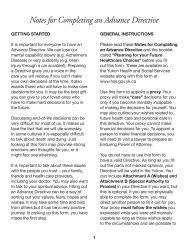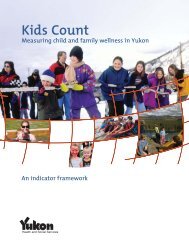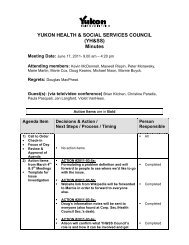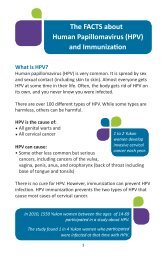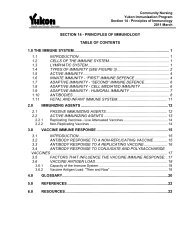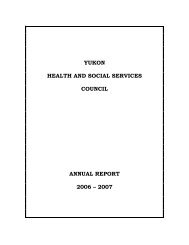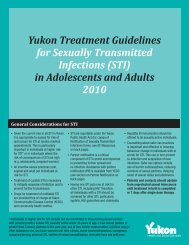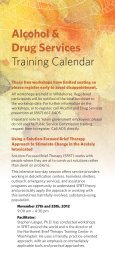Yukon Rabies Risk Management - Guidelines - Health and Social ...
Yukon Rabies Risk Management - Guidelines - Health and Social ...
Yukon Rabies Risk Management - Guidelines - Health and Social ...
Create successful ePaper yourself
Turn your PDF publications into a flip-book with our unique Google optimized e-Paper software.
<strong>Rabies</strong> Post-Exposure Prophylaxis<br />
Question 1: Was rabies post-exposure prophylaxis recommended?<br />
The decision to administer rabies post-exposure prophylaxis (RPEP) is made by the CMOH. If the risk to the exposed<br />
person (patient) is high enough that RPEP is either administered or offered, the public may need to be informed of a<br />
past or ongoing risk to public health due to the presence of a rabid animal. This is necessary in order to assess <strong>and</strong>/<br />
or treat unreported exposures, <strong>and</strong> to prevent further exposures to both humans <strong>and</strong> other animals.<br />
Question 2: If yes, is a public communications strategy required?<br />
The decision to recommend RPEP may incorporate some or all of the information used to determine whether or not<br />
to carry out a public communications strategy. However, other information will also be used, such as the vaccination<br />
status of the exposed person. Therefore, it’s important to know why rabies post-exposure prophylaxis was or was<br />
not administered or offered.<br />
To determine whether or not to recommend a public communications strategy based the decision for rabies postexposure<br />
prophylaxis, consult with the CMOH <strong>and</strong> follow their direction.<br />
Animal <strong>Management</strong><br />
Question 1: Was an animal management strategy implemented?<br />
Animal management strategies are determined by the Chief Veterinary Offi cer (CVO) in consultation with the CFIA.<br />
Depending on the specifi c animal management strategy, the public may need to be informed of a possible risk to<br />
public health due to the presence of a rabid animal. This is necessary in order to assess <strong>and</strong>/or treat unreported<br />
exposures to both humans <strong>and</strong> other animals. Refer to Animal <strong>Health</strong> Tab for details.<br />
Question 2: If yes, is a public communications strategy required?<br />
Decisions on appropriate animal management strategies may incorporate some or all of the information used to<br />
determine whether or not to carry out a public communications strategy. However, information may be interpreted<br />
or weighted differently, <strong>and</strong> tolerances may be lower when considering the risk an animal poses to human health<br />
(e.g., if available, a wild or feral domestic animal that bites someone will always be euthanized, but not necessarily<br />
because rabies is suspected). Therefore, it’s important to know why a particular animal management strategy was<br />
put in place.<br />
To determine whether or not to recommend a public communications strategy based the decision for an animal<br />
management strategy, consult with the CVO <strong>and</strong> follow their direction.<br />
Question 3: If an animal management strategy was implemented, what were the results?<br />
The result of an animal management strategy is important to know because one possible outcome is that the<br />
animal could develop clinical signs consistent with rabies. The animal may also die for other reasons, or may remain<br />
healthy. Depending on the results, the public may need to be informed of a possible risk to public health due to<br />
the presence of a rabid animal. This is necessary in order to assess <strong>and</strong>/or treat non-reported exposures to both<br />
humans <strong>and</strong> other animals.<br />
10<br />
ENVIRONMENTAL HEALTH SERVICES GUIDELINES | October 2011



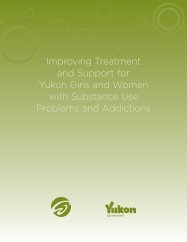
![Women and Alcohol: A women's health resource [2326.26 KB ]](https://img.yumpu.com/22340649/1/190x245/women-and-alcohol-a-womens-health-resource-232626-kb-.jpg?quality=85)
